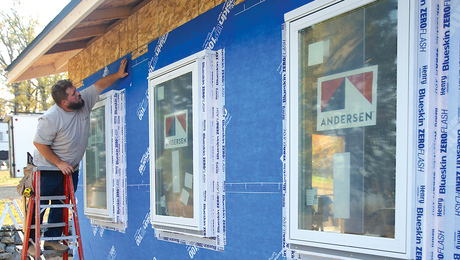I’m working with a couple (both doctors) who would like the new UV type of air purification system for the new hvac system we’ll be adding, and for upgrading the existing system. Any recomendations and suggestions on makes, installation pitfalls, and efficiency, etc. would be appreciated.
Discussion Forum
Discussion Forum
Up Next
Video Shorts
Featured Story

Getting the details right for a wall assembly with the control layers to the exterior and lots of drying potential.
Featured Video
Builder’s Advocate: An Interview With ViewrailHighlights
"I have learned so much thanks to the searchable articles on the FHB website. I can confidently say that I expect to be a life-long subscriber." - M.K.
Fine Homebuilding Magazine
- Home Group
- Antique Trader
- Arts & Crafts Homes
- Bank Note Reporter
- Cabin Life
- Cuisine at Home
- Fine Gardening
- Fine Woodworking
- Green Building Advisor
- Garden Gate
- Horticulture
- Keep Craft Alive
- Log Home Living
- Military Trader/Vehicles
- Numismatic News
- Numismaster
- Old Cars Weekly
- Old House Journal
- Period Homes
- Popular Woodworking
- Script
- ShopNotes
- Sports Collectors Digest
- Threads
- Timber Home Living
- Traditional Building
- Woodsmith
- World Coin News
- Writer's Digest


















Replies
UVC's work best when installed such that they can keep the cooling coil clean. You didn't say what type of equipment the have or will have. In a residential style upflow furnace with an A-coil on top, the pair of UV lights would be installed on top of the coil to expose both sides. Upstream of the ccoling coil, if accessible, is prefered, but direct exposure is more important than which side. Upstream is frequently wholly or partially blocked by condensate pans. Check out the article on same in the current issue of Engineered Systems, at esmagazine.com . I don't have manufacturers of the product handy now, but can get back to you on this. Had a vendor of one product in my office a few months ago.
Regular replacement of the elements is required, once a year, I beleive. Only pitfall I know of, other than cost. They are effective and will noticeably keep the coil and everything else in the system cleaner of mold and dust. Long term, no one knows yet. UV purification of water has been an effective treatment for several decades. I like it. When I upgrade my furnace this fall, I will install one in my house.
Tim
Interesting mag. One article there said:
"Though not presently sanctioned by health care construction and design guidelines, the "precursor" CDC infection control guidelines do recognize that "as a supplemental air-cleaning measure, UVGI is effective in reducing the transmission of airborne bacterial and viral infections in hospitals ... but it has only minimal inactivating effect on fungal spores"10 and bacterial spores16 . "
That wa the article: The Answer is 3 When it comes to engineering solutions for IAQ in health care facilities, the combination of dedicated ventilation, microbial filtration, and ultraviolet germicidal irradiation ...."
Was that thew one to which you refer?
Is it true that the type of UV used for this application can be damaginbg to eyes?
Yes, that was the article. It is an interseting publication. I don't know if it is damaging to your eyes, though, I would not recommend looking at the elements for any extended period of time. I would bet that it is damaging. However, it works. I've seen tests in real-life, installed equipment. (The CDC is a semi-polital, governmental agency, that will eventually learn more about this, and most likely endorse UVGI)
And, as the article pointed out, the answer is 3, of which this is only 1.
Tim
Thanks.
FYI, these things were recently discussed on the American Society of Home Inspectors members forum. Avery knowledgable inspcetor named Jerry Peck posted the following:
QUOTE
UV lights are available in UVa, UVb and UVc. UVc is higher energy and is used to kill bacteria (and is considered harmful to people).They use UVc lights to help kill bacteria, mold, etc. in the return air stream and on the evaporator coil. I've been told they work well for those uses. You need to turn the lights off before looking or working in there.However (the big however), the UV destroys the insulation on the conductors (especially UVc), leaving bare wiring hanging anywhere the UVc reaches. The UVc also damages other things not UVc resistant (plastic condensate pans, pvc condensate piping, foam insulation on refrigerant piping, etc.).
ENDQUOTE